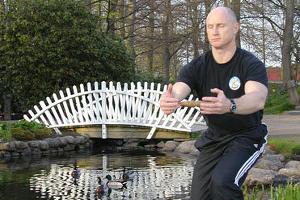Should Athletes Stretch Before Training or Competing?
by Paul Chek

 Should athletes stretch before lifting weights, training or competing? This is a question athletes don’t ask often enough.
Should athletes stretch before lifting weights, training or competing? This is a question athletes don’t ask often enough.
Unfortunately, a lot of athletes get injured because they don’t have adequate knowledge of biomechanics and kinesiology, but neither do most trainers and coaches.
Recently, I was asked this question by a student on my YouTube page and thought it would be wise to share my answer with as many of you as possible, in hopes that you can prevent unwanted injuries for those you train or coach or for yourself.
foleskin foley: Hi Paul. I’m currently in college doing personal training! They are saying not to stretch before workouts but I know you advocate stretching before! Just wondering your thoughts? I’m doing HLC 1 in October. Love and chi!
The challenge you want to be aware of is “static stretching” — stretching with long holds (60 seconds or more) — which can lengthen the fascia and change the neuromuscular function of a muscle.
When this occurs, and one begins an athletic activity, such as weight lifting, swinging a golf club or sprinting, the muscles that have been stretched this way will not have a length-tension pattern that matches the information stored in the motor program one has developed in the brain (sensory motor cortex and cerebellum).
What occurs after such stretching and initiating movements (particularly fast movements) is that the central nervous system (CNS) will sense the difference in the length of the stretched muscle relative to the motor engram in the CNS and seek to adjust it to match the motor engram.
This process creates a period of “motor confusion” because the sensory information coming to the CNS from the involved muscle-joint complex doesn’t match.
This creates a period of functional instability in the motor system, and results in the brain not being able to execute the stored motor engram due to the mismatch of sensory feedback information. At this time, one is highly susceptible to muscle-tendon-joint injuries.
Preventing injuries
A very good example of this, which I’ve seen occur many times in my career, is when a sprinter goes out to the track, does long hold static stretching on his/her hamstrings, then starts sprinting.
When sprinters come out of the blocks and accelerate — the knee joints of a sprinter can easily hit speeds of 1,000 degrees per second — because their movements are so fast, which requires very precise control of the muscle-joint complexes, the background tension generated by the sensory-motor system to normalize the muscle length-tension to match the stored motor engram disrupts fine motor control.
When the knee is rapidly extending (there should be a controlled eccentric contraction of the hamstrings), there is a background contraction generated to attempt to normalize muscle length, which disrupts fine motor control and commonly results in hamstring tearing.
You’ve probably seen this before. When a sprinter comes out of the blocks, often within the first 30 meters, suddenly they jump into the air and grab their hamstring in pain. Sometimes, they even fall to the ground because the pain of the tear is so great.
I spent many years working with elite track and field athletes, distance runners, gymnasts and a wide variety of athletes. Over the years, I’ve tested them by performing different types of stretching before they did various practice runs.
Not only did I time-track athletes, but I asked them for feedback on how they felt. After static stretching, athletes consistently reported a sense of instability and often felt an unexplainable weakness, plus a lack of power and responsiveness from the muscles that had been stretched.
When I used contract/relax stretching with a five-second contraction followed by five seconds of relaxation — lengthening the muscle — this did not occur.
Also, I found that, in certain situations — when an athlete had a lot of scar tissue from a previous injury to their hamstrings or fascia — I needed to do long hold stretching to mobilize the scar and fascia.
And, when I had athletes do stabilization exercises (either on the ground or with a Swiss ball for 1-2 minutes), then do their event, they did not experience the motor challenges they had when doing static stretching alone.
In addition, I found that doing deep pressure release (like acupressure techniques) or deep tissue work before an athletic event produced the same challenges as long hold stretching.
This is important because I’ve seen massage therapists doing deep tissue work on athletes many times right before events, which is actually dangerous to the athlete for the reasons cited above.
If deep tissue work is needed to mobilize the body in key areas, and stabilization work or rhythmic stabilization exercises (such as the Bodyblade) are used, normalization occurs within about 1-2 short sets of 1-2 minutes of exercise.
There is a comprehensive chapter in my book, The Golf Biomechanic’s Manual, that covers stretching in detail, as well as neuromuscular mobilization techniques (Feldenkrais exercises) and suggestions on what types of stretching should and shouldn’t be used before training or athletic events. The book’s title suggests that it’s only for golfers, but the actual assessment and stabilization training sections apply across the board, so there’s lots you can learn from it.
(FYI, my CHEK Exercise Coach program features a complete and comprehensive certification plan too.)
Love and chi,
Paul



